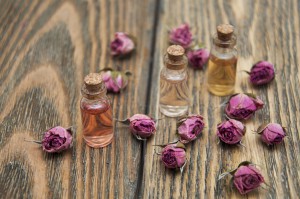After a long, stressful day, many people find comfort in aromatic candles. This calming ritual is rooted in the art of aromatherapy, and the use of distinct smells to combat stress dates back to the ancient Egyptians. A common misconception of aromatherapy is that the benefits are restricted to emotional remedies, but various practitioners will argue that the healing goes much deeper, and can effect people on a physical level.

Creating layers of specific scents can yield many pleasant results, especially when applied during a massage or spa treatment. We’re diving into the theory and science of aromatherapy to understand how scent can trigger a physical reaction. And while a certain level of controversy remains, more and more studies are revealing that there’s more to aromatherapy than meets the nose.
The Theory of Aromatherapy
Aromatherapy falls under the umbrella of alternative medicine. The theory is based on the belief that scents stimulate the olfactory system, and subsequently cause a response from the body. According to the theory, these responses can cause a person to relax, brighten, or heal. It’s important to note that practitioners will only utilize specific scents in aromatherapy, which are generally derived from essential oils and aromatic plant compounds. The scents are inhaled via diffusers, candles, or massage oils, and are believed to cause an immediate reaction. So where does the traditional medical community stand on aromatherapy? It boils down to the science.
The Science Of Aromatherapy
While there have been ample debates on the scientific truths behind aromatherapy, recent studies are revealing that the effects are substantial. A report compiled by the U.S. National Library of Medicine states that aromatherapy is a derivative of herbal medicine, and that the applications have historically ranged from emotional support to whooping cough. The report went on to surmise that various aromas were indeed impacting the olfactory bulb, and causing subjects of 2014 study to show sedative and stimulant symptoms from the aromas.
How do these symptoms occur? The nerves used to detect scent are located high in the nose, and connect directly to the brain. Aromatics release tiny molecules into the air that you breathe in, setting off olfactory nerve cells. The cells send a message up to the brain where the smell can ignite a reaction that travels through the entire body. This translates to physical reactions such as increased heart rate or emotional reactions such as calmness.
Aromatherapy continues to be categorized as alternative medicine, and is joined by treatments including acupuncture, massage, and magnet therapy. Alternative medicine is also used to categorize dietary practices such as vitamin regiments and herbal teas. Even though all of these practices are considered alternative, they’re transitioning into mainstream forms of medical care. In fact, acupuncture and massage therapy (both of which commonly incorporate aromatherapy) are becoming increasingly available through insurance plans.
How We Use Aromatherapy at Burke Williams
We are firm believers in the power of aromatherapy, and our skilled technicians incorporate this revered practice whenever possible. We offer an array of treatments including Hunter’s Retreat, which applies several essential oils to achieve the highest state of relaxation. We also offer aromatherapy enhancements to all of our massage treatments. For the enhancements, guests choose one of our specially formulated lotions to take the experience to the next level. We also ensure that calming scents travel throughout the spa, adding aromatic layers of relaxation to your visit.
